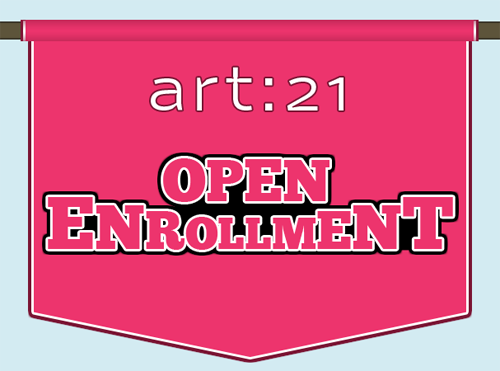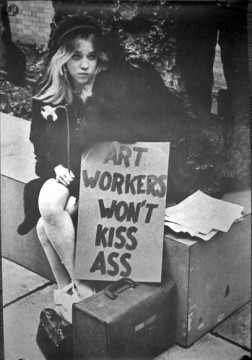On Friday, April 8th, two members from Temporary Services, Brett Bloom and Salem Collo-Julin, gave a presentation on their practice at Outpost for Contemporary Art here in Los Angeles. The audience completely filled Outpost’s modestly sized space, with those that arrived late having to sit on the floor and others standing in the doorway. I didn’t recognize everyone but a handful of LA’s progressive practitioners were on hand including Robby Herbst, co-founder of the Journal of Aesthetics & Protest, artist and cycling activist Lisa Anne Auerbach and Sarah Delaiden of the Los Angeles Urban Rangers.
Formed in 1998 and based in Chicago (although Bloom currently resides in Copenhagen), Temporary Services are a complex group with many years and dozens of publications and projects under their belts. They’ve been around for quite some time and are certainly distinct from the growing, modish attention directed towards artist collectives presently. One particularly successful project from 2009 was a release of the newspaper stock publication Art Work: A National Conversation about Art, Labor and Economics. Published through their press, Half Letter Press and available for free download, the publication was released in every state including Puerto Rico. With contributions from art historian and critic Julia Bryan-Wilson, author of 2009’s Art Workers: Radical Practices in the Vietnam War Era, art historian and artist Greg Sholette, curator Nato Thompson, artist Harrell Fletcher among many others, the publication is both a rich resource on the topic of labor and artistic production and also a call to action.

Stacks of "Art Work: A National Conversation on Art, Labor, and Economics." Courtesy studiochicago.org.
In the last few years, the discussion of art, labor, and economics has been reignited. One obvious reason stems from the current recession and how it has affected public funding structures for non-profits, education, arts organizations, and many invaluable social resources. We have also experienced a type of re-visitation to art historical precursors, such as the Art Workers’ Coalition, in what seems to be constitutive of a historical looking back in order to gain perspective on the present. During the discussion portion of the presentation, the crowd expressed varied concerns. A self-identified artist in the audience asked about how artists can ensure stable compensation when their work is viewed in museums, subject to admission fees while simultaneously, artists are not given anything beyond minimal honorariums and the non-monetary, cultural currency of exhibiting at a museum. Another person, an adjunct faculty member at the California Institute for the Arts (CalArts) asked about organizing strategies in the present moment, with its expanded Internet networking technologies and the full-on “MFA factory” condition of the art economy in late capitalism. There was also another comment made about the various forms of temporary and/or part-time employment, both within and outside of clearly delineated art contexts, such as studio assistants, part-time retail work, and — what I’ve seen increasingly, childcare and home nannying — that many artists and other cultural producers do in order to facilitate their own practices. This is, of course, done in full cognizance that few are able to climb the ranks towards financial stability in the opacity of art. And yet, we do it anyway.
It is not surprising, then, that my group of young curators, artists and writers in the USC Master of Public Art Studies program decided to take on this topic for our final exhibition project, one of the two requirements for graduation (the other being our individual thesis manuscripts). It is certainly impossible to work towards complete consensus in a group of 12 diverse graduate students with differing professional and personal interests. But the conceptual theme of artistic production and economic conditions resonated with us because, despite our differences, we are all feeling the anxiety of entering the job market, with a steep amount of educational debt in our pockets, moving from one fairly comfortable area of the art economy (graduate school) to another that is quite amorphous.
Our exhibition (cue self promotion here) is titled Work After Work. We hope to continue the conversation with the inclusion of institutional critique forerunners Michael Asher’s artist contracts and Andrea Fraser’s prospectuses, to younger artists that explicitly address the instability of artistic production in their own practices, including the LA-based collective Eternal Telethon. The collective broadcast telethons online of performances by their network of artists and friends to secure donations for an artist convalescent home playfully signify the lack of social resources for creative work. In addition to the work in the exhibition, I will be moderating a panel called “Negotiating Institutional Relationships” with W.A.G.E (Working Artists in the Greater Economy), writer and educator Sue Bell Yank of the Hammer Museum, and Robby Herbst, mentioned above. The precarity of artistic labor is real and the multiplicity of issues and concerns raised during the Temporary Services presentation, which seamlessly flowed into a dynamic discussion and spilled over two hours, is indicative of a widely held desire to take on issues within the varied institutional contexts of art and to ultimately transform the economic inequalities in which we are all implicated. It will certainly be no easy feat for us to accomplish so remember, don’t quit your day jobs.
Now, get back to work.
Work After Work runs April 28-May 8 at the MAK Center for Art and Architecture (Mackey Garage Top, 1137 S. Cochran Avenue, Los Angeles, CA 90019). Exhibition contributors include: Michael Asher, Joseph del Pesco, Eternal Telethon, Andrea Fraser, Alex Israel, Sharon Lockhart, Yvonne Rainer, Kenneth Tam, Anton Vidokle, and Carey Young with program participants: Sarah Wookey, W.A.G.E, Sue Bell Yank, and Robby Herbst. Curated by the USC Master of Public Art Studies: Art/Curatorial Practices in the Public Sphere, Class of 2011.





